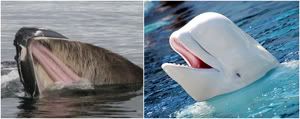I'm assuming all my readers know the difference between a toothed whale like an orca and a baleen whale like a humpback. If not, there's your homework assignment.

When and why did these two groups of whales form? Well, we have a glimpse of that now.
Fossils and morphological evidence has suggested that the groups diverged about 25 million years ago, but there was no genetic evidence to support this.
"Now biologists at the University of California, Riverside provide the first genetic evidence for the loss of mineralized teeth in the common ancestor of baleen whales."
What's more is that the genetic evidence lines up perfectly with the existing fossil evidence.
"We show that the genetic toolkit for enamel production was inactivated in the common ancestor of baleen whales," said Mark Springer, a professor of biology, who led the research. "The loss of teeth in baleen whales marks an important transition in the evolutionary history of mammals, with the origin of baleen laying the foundation for the evolution of the largest animals on Earth."
Baleen whales are able to grow much larger because of their feeding habits. Think of it like this: A dolphin eats fish which it has to individually capture. A massive blue whale, on the other hand, does not have enough hours in the day to spend individually capturing tiny fish. It is much more efficient for a large whale to move down the food chain to the base where more and more biomass is available. Keep in mind the amounts of animals in each tropic level: There are many many more planktonic species available because they feed all the small fish, which in turn feed all the medium-sized fish, which in turn feed all the larger fish, and so on and so on until we get up to whales. In each level upwards there are less and less animals that can rely on the food source beneath them. For example, we have far fewer sharks than minnows (ignoring for the moment the gross and tragic exploitation of sharks).
"Next, the researchers plan to piece together the complete evolutionary history of a variety of different tooth genes in baleen whales to provide an integrated record of the macroevolutionary transition from ancestral baleen whales that captured individual prey items with their teeth to present-day behemoths that entrap entire schools of minute prey with their toothless jaws."
Full article here (Science Daily)
No comments:
Post a Comment